Paul Gilster's Blog, page 59
November 4, 2020
Speculations on Starless Worlds
Yesterday’s paper from Matt Clement and team reminded us of the enormous transformation that can take place in a planetary system as it lurches toward eventual stability. Gas giants have so much to say about how this process occurs, with their gravitational interactions sometimes ejecting other worlds from the system. Ejected planets are often called ‘rogue’ planets because they wander the galaxy without orbiting a star. Their numbers may be vast.
Clement and team think we may have ejected an ice giant from our early system, as we discussed yesterday. Whatever the case, I’ve been talking about rogue planets for about ten years, and as I look back, I run into intriguing finds like PSO J318.5-22, which is described in a 2013 paper from Michael Liu and colleagues (citation below). Says Liu (University of Hawaii):
“We have never before seen an object free-floating in space that looks like this. It has all the characteristics of young planets found around other stars, but it is drifting out there all alone.”
We learn from the paper that this object shows similarities to young, dusty planets in terms of luminosity, mass, spectrum, etc. It’s also useful because it’s likely a member of the β Pic moving group, meaning we can glean something about its age, about 12 million years. Have a look.
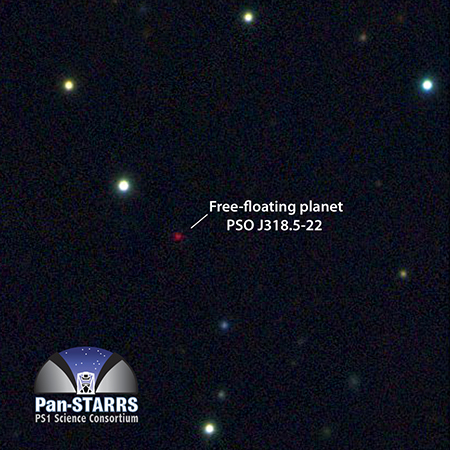
Image: One apparent free-floating planet turned up in a search for brown dwarfs. This multicolor image is from the Pan-STARRS1 telescope, showing PSO J318.5-22, in the constellation of Capricorn. The planet is extremely cold and faint, with most of its energy emitted at infrared wavelengths. The image is 125 arcseconds on a side. Credit: N. Metcalfe & Pan-STARRS 1 Science Consortium.
Estimates of the number of rogue planets are all over the map, with one recent one being 2000 objects ranging in size between the Moon and Jupiter per main sequence star. That’s from a 2018 study by Xinyu Dai & Eduardo Guerras (University of Oklahoma), but if we want to jump to the high end, we can go with Louis Strigari (Stanford University) and colleagues: 105 compact objects per main sequence star. See Island Hopping to the Stars for Strigari, and Detection of Extragalactic Planets? for Dai and Guerras, where I give citations.
Now we have word of a small rogue world probably about the size of the Earth. Przemek Mroz (California Institute of Technology) is lead author of the study. Detected through gravitational microlensing, which is about the only way it could have been found with our current technologies, the world is labelled OGLE-2016-BLG-1928. This is the smallest rogue candidate yet identified, with the microlensing event having a timescale of a scant 42 minutes.

Image: An artist’s impression of a gravitational microlensing event by a free-floating planet. Credit: Jan Skowron / Astronomical Observatory, University of Warsaw.
Gravitational microlensing occurs when a foreground star (or planet, in this case) moves in front of a background stellar object, causing the light from the more distant star to be magnified. A brief burst in magnification becomes the signal identifying the star and any associated exoplanet, but in the case of rogue planets, we have no central star. Here’s Mroz on the matter:
“If a massive object (a star or a planet) passes between an Earth-based observer and a distant source star, its gravity may deflect and focus light from the source. The observer will measure a short brightening of the source star. Chances of observing microlensing are extremely slim because three objects – source, lens, and observer – must be nearly perfectly aligned. If we observed only one source star, we would have to wait almost a million year to see the source being microlensed.”

Image: Changes of brightness of the observed star during the gravitational microlensing event by a free-floating planet. Credit: Jan Skowron / Astronomical Observatory, University of Warsaw.
Given how few of these objects we have detected, and the wide range of estimates in the population of rogue planets, it’s hard to make too many statements about them. Are they all the likely result of gravitational interactions in an infant or maturing stellar system? Is there a risk of mistaking ultracool brown dwarfs for planets in this regime (I assume the answer is yes)? In the case of OGLE-2016-BLG-1928, are we absolutely sure there is no host star? Consider this passage from the paper:
The discovery of OGLE-2016-BLG-1928 demonstrates that current microlensing surveys are capable of finding extremely-short-timescale events. Although the mass of the lens cannot be unambiguously measured, properties of the event are consistent with the lens being a sub-Earth-mass object with no stellar companion up to the projected distance of ∼ 8 au from the planet. Thus, the lens is one of the best candidates for a terrestrial-mass rogue planet detected to date. This population of low-mass free-floating (or wide-orbit) planets may be further explored by the upcoming microlensing experiments.
Would OGLE have detected a star here if the planet in question was at Saturn’s 10 AU distance from it? This was one tricky detection, “at the edge of current limits of detecting short-timescale microlensing events,” according to the authors. It’s suggestive of a rogue planet. Looking ahead, we’re also moving toward a space-based microlensing capability in the Nancy Grace Roman Space Telescope (WFIRST). Future surveys will doubtless turn up rogue planets that will add to the ground-breaking work accomplished by dedicated ground-based surveys like OGLE.
And I wonder: What happened to that third ice giant that was ejected from our early Solar System? Is it out there wandering the galaxy, yet another rogue far from the star of its birth?
The paper is Mroz et al., “A terrestrial-mass rogue planet candidate detected in the shortest-timescale microlensing event,” Astrophysical Journal Letters Vol. 903, No. 1 (29 October 2020). Abstract / Preprint. The Liu paper is “The Extremely Red, Young L Dwarf PSO J318-22: A Free-Floating Planetary-Mass Analog to Directly Imaged Young Gas-Giant Planets,” Astrophysical Journal Letters Vol. 77, No. 2 (22 October 2013). Abstract.






November 3, 2020
Jupiter, Saturn and the Early Solar System
The days when scientists assumed our Solar System would be something of a template for planetary systems elsewhere are long past. The issue now is to delve deeper into system architectures to figure out what happens in their infancy and how they evolve. Working backward from today’s Solar System is one way to approach the problem. Thus Matt Clement (Carnegie Institution for Science), who has led a recent study into the formation of Jupiter and Saturn, hoping to determine how they wound up in their present orbits. Says Clement:
“We now know that there are thousands of planetary systems in our Milky Way galaxy alone. But it turns out that the arrangement of planets in our own Solar System is highly unusual, so we are using models to reverse engineer and replicate its formative processes. This is a bit like trying to figure out what happened in a car crash after the fact–how fast were the cars going, in what directions, and so on.”

Image: New work led by Carnegie’s Matt Clement reveals the likely original locations of Saturn and Jupiter. Credit: Saturn image is courtesy of NASA/JPL-Caltech/Space Science Institute.
As you would imagine, work like this involves numerous computer simulations, some 6,000 of which are described in the paper in Icarus. The Solar System we were born into emerges in these simulations from conditions that were markedly dissimilar in the early days of planet formation, when the larger bodies in the system began to spring gravitational surprises on a tidy early arrangement, with a re-shuffling that gave shape to today’s orbital stability.
Our models for how all this happened are now being tweaked, as exemplified by Clement and team’s work. Whereas Jupiter was once believed to orbit the Sun three times for every two orbits completed by Saturn — this has evolved within the ‘Nice Model’ of system formation — the new computer simulations show that the arrangement of planets we have today is better produced by starting with a ratio of two Jupiter orbits to one Saturn orbit.
As the authors put it, “adequately exciting Jupiter’s eccentricity without exceeding Jupiter and Saturn’s modern orbital spacing is extremely challenging.” The Nice Model (named after the city in France, where it was originally developed at the Observatoire de la Côte d’Azur) considers the migration of the giant planets after the dissipation of the early protoplanetary disk. Clement’s simulations show the effect of the Kuiper Belt on the positions of Uranus and Neptune, with signs of an early ice giant that was ejected during the roiling period of system formation.
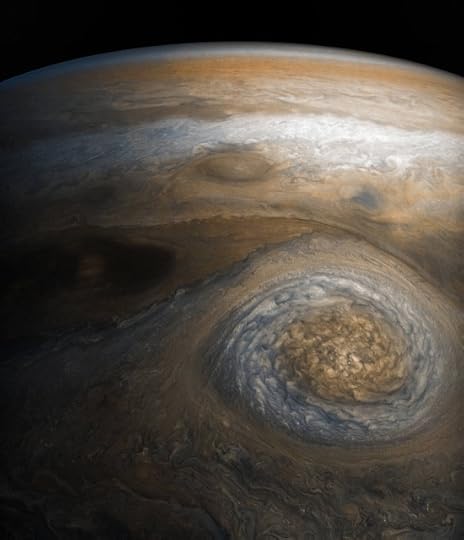
Image: Jupiter in its infancy was thought to orbit the Sun three times for every two orbits that Saturn completed. But this arrangement is not able to satisfactorily explain the configuration of the giant planets that we see today. Matt Clement and his co-authors showed that a ratio of two Jupiter orbits to one Saturnian orbit more consistently produced results that look like our familiar planetary architecture. Credit: NASA.
In the Nice Model, the planets emerge from the protoplanetary disk in a compact, resonant configuration, with subsequent perturbations breaking the resonance of one or more planets, creating a phase of dynamical instability that reshapes the outer Solar System. The Nice Model is widely accepted in the field because of its ability to predict the orbital shape of the Kuiper Belt and main asteroid belt, and properties of some gas giant moons.
The Nice Model seems strong, and as the paper points out, its simulations replicate the capture of irregular moons in the outer Solar System and allow the survival of the asteroid belt while explaining the trojan asteroids. As the authors go on to say, “A major potential pitfall of the primordial 2:1 version of the Nice Model presented in this manuscript is its effects on the asteroid belt and terrestrial-forming regions.”
Hence the need to investigate the consequences of the proposed scenario on the inner Solar System. But the paper discusses the problems resolved by assuming an initial 2:1 resonance. The authors acknowledge that some aspects of the system’s present architecture are still low-probability outcomes. A major issue is eccentricity. Were the gas giants actually born in a 2:1 resonance and in orbits that were at origin somewhat eccentric?
That scenario, described as “somewhat of a paradigm shift,” does produce the modern Jupiter-Saturn orbits and is consistent with the position of Uranus and Neptune, with this addition: “…we show that Uranus and Neptune’s final orbits are determined by a combination of the mass in the primordial Kuiper belt and that of an ejected ice giant.” Adds Clement:
“This indicates that while our Solar System is a bit of an oddball, it wasn’t always the case. What’s more, now that we’ve established the effectiveness of this model, we can use it to help us look at the formation of the terrestrial planets, including our own, and to perhaps inform our ability to look for similar systems elsewhere that could have the potential to host life.”
As we tighten the Nice Model further, the paper describes the research path ahead:
Though our work shows that the primordial 2:1 Jupiter–Saturn resonance is a viable evolutionary path for the solar system, future work is still required to fully validate our presumed initial conditions, and robustly analyze the consequences of such a scenario on the solar system’s fragile populations of small bodies. In particular, follow-on investigation of the giant planets’ instability evolution with Jupiter and Saturn in a primordial 2:1 MMR with enhanced eccentricities must consider longer integration times (≳100 Myr), higher resolution disks (≳10,000 particles), and account for the dissipating gaseous nebula.
Clement presented these results at the American Astronomical Society’s Division for Planetary Sciences virtual meeting, which ended on the 30th of October.
The paper is Clement et al., “Born eccentric: Constraints on Jupiter and Saturn’s pre-instability orbits,” Icarus Vol. 355 (February 2021), 114122 (abstract).






October 30, 2020
Getting Ready for Dragonfly: Titan’s Impact Craters
What accounts for the differences in Titan’s craters? It will be helpful from an operational standpoint to learn more, for in 2027 the Dragonfly mission will launch, with Selk Crater a target. An equatorial dune crater, Selk is completely covered in a dark organic material, unlike other higher-latitude craters on the Saturnian moon that are scoured and cleansed by rain. We have learned from data produced by Cassini’s Visible and Infrared Mapping Spectrometer (VIMS) that Titan’s craters come in two kinds. Equatorial craters like Selk occur in dune fields and consist mostly of organics. Mid-latitude craters show a mix of organics and water ice.
The organic material generated by processes in Titan’s thick atmosphere is sand-like, piling up in equatorial regions but being eroded at the higher, wetter latitudes. For Dragonfly’s purposes, we want to know more about how the methane rain and streams affect the surface as we fine-tune the data analysis and monitoring techniques to be used in the mission.
What’s happening in Titan’s craters reminds us just how active the surface here is, says Anezina Solomonidou, a research fellow at the European Space Agency and lead author of a paper that explores the issue:
“The most exciting part of our results is that we found evidence of Titan’s dynamic surface hidden in the craters, which has allowed us to infer one of the most complete stories of Titan’s surface evolution scenario to date. Our analysis offers more evidence that Titan remains a dynamic world in the present day.”
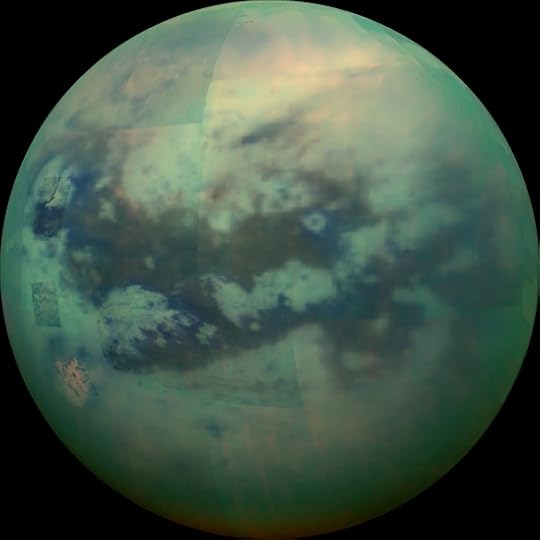
Image: This composite image shows an infrared view of Saturn’s moon Titan from NASA’s Cassini spacecraft, acquired during the mission’s “T-114” flyby on Nov. 13, 2015. The spacecraft’s visual and infrared mapping spectrometer (VIMS) instrument made these observations, in which blue represents wavelengths centered at 1.3 microns, green represents 2.0 microns, and red represents 5.0 microns. A view at visible wavelengths (centered around 0.5 microns) would show only Titan’s hazy atmosphere. The near-infrared wavelengths in this image allow Cassini’s vision to penetrate the haze and reveal the moon’s surface. Credit: NASA/JPL/University of Arizona/University of Idaho.
Look closely at the above image and you’ll see Titan’s largest confirmed impact crater, called Menrva, near the limb above center to the left. Cassini was at about 10,000 kilometers from the moon during this approach, a good deal higher than many flybys, but the altitude allowed the VIMS instrument to cover wide areas at moderate resolution. You can also see two dark bands, parallel regions filled with dunes at the center of the image, with some regions of finer resolution inset in the image; these were acquired near the spacecraft’s closest approach.
But back to the evolution of those craters, which is the subject of the paper in Astronomy & Astrophysics. The differences between craters are telling, for they point to different evolution depending on geography. When objects make it through Titan’s atmosphere to impact on the surface, the heat generated by the event mixes organic materials and water ice from below. The cleansing methane rain subsequently falls in the mid-latitude plains, whereas in the equatorial regions, the impact areas are covered by a layer of sandy organic sediment.
The two classes of impact crater are strikingly different. Processes after the impact account for the outcomes. From the paper:
These observations agree with the evolution scenario proposed by Werynski et al. (2019), wherein the impact cratering process produces a mixture of organic material and water ice, which is later “cleaned” through fluvial erosion in the mid-latitude plains. However, the cleaning process does not appear to operate in the equatorial dunes; rather, the dune craters are quickly covered by a thin layer of sand sediment. This scenario agrees with other works that suggest that atmospheric deposition is similar in the low-latitudes and midlatitudes on Titan, but with more rain falling onto the higher latitudes causing additional processing of materials in those regions… In either case, it appears that active processes are working to shape the surface of Titan, and it remains a dynamic world in the present day.
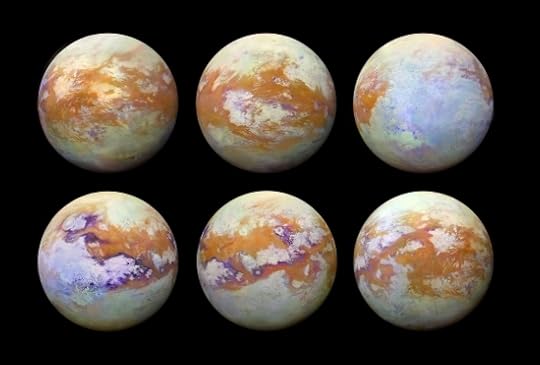
Image: These six infrared images of Saturn’s moon Titan represent some of the clearest, most seamless-looking global views of the icy moon’s surface produced so far. The views were created using 13 years of data acquired by the Visual and Infrared Mapping Spectrometer (VIMS) instrument on board NASA’s Cassini spacecraft. Credit: NASA/JPL-Caltech/Stéphane Le Mouélic, University of Nantes, Virginia Pasek, University of Arizona.
With a sea of water and ammonia beneath the crust, Titan is a place where a large impact will move organic materials between the surface and the ocean below, highlighting the significance of Dragonfly’s future work at Selk Crater as a way to probe the moon’s composition. And while it seems likely that erosion has obscured most impact craters from Titan’s past, we do have 90 potential features, according to the paper, that may be craters to work with. These features offer a window into the atmosphere’s influence on the surface through weathering while exposing material from the interior which Cassini’s RADAR instrument was unable to probe.
The paper is Solomonidou et al., “The chemical composition of impact craters on Titan,” Astronomy & Astrophysics Vol. 641, A16 (September 2020). Abstract.






October 29, 2020
The Galactic Bulge: A Single Burst of Star Formation?
Discussions of the Milky Way’s center have always attracted me. Here we find ancient stars, with all that suggests about the possibility of long-lived civilizations, but occurring in a place where ionizing radiation associated with the galaxy’s supermassive black hole (Sagittarius A*) may push the habitable regions out into the galactic suburbs. And then there are all those supernovae to contend with! Maybe life in these parts is, if present, single-celled, perhaps underwater, with brief land colonization before new extinction events erase it.
Whatever the case, I’m learning that the galaxy’s central bulge is inspiring a new wave of study. A survey of millions of stars there is producing insights into how the bulge originally formed. We can look at spiral galaxies near and far and find commonality in their central bulge of stars surrounded by the familiar disk, but if the bulge stars formed in a single burst of activity, we could be seeing a population as old as 10 billion years in our home galaxy. But it has also been argued that waves of star formation have occurred in the bulge, so that some stars there may constitute a population as relatively ‘young’ as three billion years, younger than the Sun.

Image: This photo looking toward the center of the Milky Way galaxy covers 0.5 by 0.25 degrees on the sky (an area about twice as wide as the full Moon) and contains over 180,000 stars. The image captures a portion of our galaxy about 220 by 110 light-years across. It was taken with the Dark Energy Camera on the Victor M. Blanco 4-meter Telescope at the Cerro-Tololo Inter-American Observatory in Chile, a Program of NSF’s NOIRLab. Credit: CTIO/NOIRLab/NSF/AURA/STScI, W. Clarkson (UM-Dearborn), C. Johnson (STScI), and M. Rich (UCLA).
The new study begins to untangle the contrasting theories of bulge star formation. It is in the hands of co-principal investigators Christian Johnson (Space Telescope Science Institute) and Michael Rich (UCLA), who used the wide-field Dark Energy Camera (DECam) on the 4-meter Victor M. Blanco instrument at Cerro Tololo in Chile to capture 3 square degrees of sky with each exposure. 250 million stars fall into the field of these observations. All told, more than 450,000 photographs have been produced and the chemical compositions of over 70,000 stars analyzed, as described in two papers on this work. Johnson describes the study:
“Our survey is unique because we were able to scan a continuous section of the bulge at wavelengths of light from ultraviolet to visible to near-infrared. That allows us to get a clear understanding of what the various components of the bulge are and how they fit together.”
What Johnson and Rich find is that most stars in the central 1,000 light years of the galaxy’s hub formed more than 10 billion years ago, perhaps triggered by a merger with another galaxy in formation, or else through accretion of infalling gas and dust. The work proceeded by analyzing the stars’ chemical compositions, which produced interesting results. Stars in this region have roughly the same metallicity (elements higher than hydrogen and helium) as the Sun. In other words, these ancient stars are somehow enriched in metals. Here’s Rich:
“Something different happened in the bulge. The metals there built up very, very quickly, possibly in the first 500 million years of its existence.”
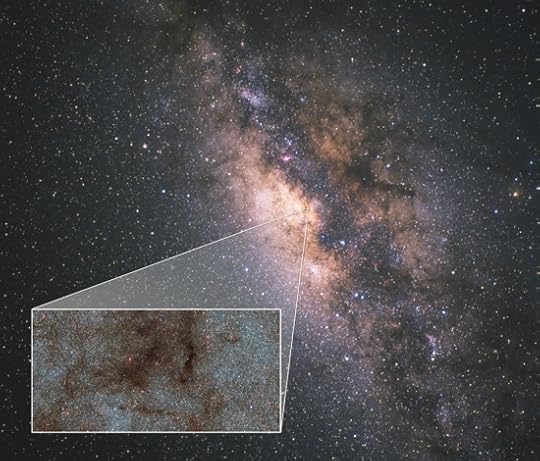
Image: This image shows a wide-field view of the center of the Milky Way with a pull-out image taken by the Dark Energy Camera (DECam) at the Cerro-Tololo Inter-American Observatory in Chile. Credit: Milky Way photo: Akira Fujii; Inset photo: CTIO/NOIRLab/NSF/AURA/STScI, W. Clarkson (UM-Dearborn), C. Johnson (STScI), and M. Rich (UCLA).
Measuring stellar brightness at different wavelengths — near-ultraviolet, optical, and near-infrared — is the key to the researchers’ method, with the ultraviolet data taking precedence. Differences in brightness depending on wavelength define photometric colors, which can be used to reveal the composition of stars when the data are calibrated against spectroscopic measurements. Stars forming at different times, we would expect, would show different levels of metallicity, but in this 1,000 light-year region, the distribution of metals is similar. Theories suggesting multiple phases of star formation over billions of years seem ruled out. From the paper:
…little physical motivation exists regarding why the bulge should be a composite of two or more populations that each have a relatively narrow, normally distributed metallicity distribution function. Systems composed of two or more populations with narrow, normally distributed metallicity distributions do exist in nature, but such objects often show extreme heavy element abundance variations that are indicative of a prolonged period of ‘bursty’ star formation and self-enrichment, particularly from low- and intermediate-mass AGB stars (e.g. ω Cen; Johnson & Pilachowski 2010; Marino et al. 2011b). The Galactic bulge shows no evidence supporting this type of enrichment pattern.
The stars analyzed in this region of the galactic bulge are enriched in metals despite their age, with a distribution of metals clustered around a single average. We seem to be looking at a single burst of star formation here. The full dataset for the Blanco DECam Bulge Survey will soon be released, offering a major resource for those investigating stellar populations within the inner disk and the galactic bulge that will be useful when combined with other imaging surveys. Up next for the authors is research into any correlations between metallicity and stellar orbits, which could uncover the remains of dwarf galaxies disrupted in this ancient phase of star formation.
The papers are Johnson et al., “Blanco DECam Bulge Survey (BDBS) II: project performance, data analysis, and early science results,” Monthly Notices of the Royal Astronomical Society 499 (3 September 2020), 2357–2379 (full text); and Rich et al., “The Blanco DECam bulge survey. I. The survey description and early results,” Monthly Notices of the Royal Astronomical Society 499 (3 September 2020), 2340–2356 (full text).






October 28, 2020
Short Takes on Events in ‘Local’ Space
You wouldn’t think that a place 100 times drier than the Sahara desert would have a lot to offer, but when that place is the sunlit surface of the Moon, the import of the new discovery from the SOFIA airborne observatory is clear. H2O in Clavius Crater, in concentrations of 100 to 412 parts per million, is said by NASA to be equivalent to a 12-ounce bottle of water trapped in a cubic meter of soil spread across the lunar surface. The results in Nature Astronomy point to interesting possibilities for future missions if the water is accessible.
Exactly what would be involved in extracting such a resource? While we try to figure that out, where the water comes from is an interesting question. Thus Casey Honniball (NASA GSFC), lead author on the SOFIA paper:
“Without a thick atmosphere, water on the sunlit lunar surface should just be lost to space. Yet somehow we’re seeing it. Something is generating the water, and something must be trapping it there.”
We also have Paul Hayne and team’s work using the Lunar Reconnaissance Orbiter to map shadowed regions, the ‘cold traps’ once thought restricted to deep craters. But micro-traps also seem to be in play, meters across and even less. The Hayne estimate is that cold traps may occupy 40,000 square kilometers, about 0.1 per cent of the moon’s surface. Between the two studies, we have reason to be energized about future human operations on the Moon.

Image: These three images of the lunar surface show shadows at all scales, from several kilometers to less than a centimeter. (A) Lunar Reconnaissance Orbiter oblique view over the rim of the Cabeus crater near the Moon’s south pole (NASA/GSFC/ASU). (B) Chang’e-3 close-up surface image taken by the Yutu rover some distance from the landing site (CNSA/CLEP). (C) Apollo 14 close-up camera image of undisturbed regolith. Some of these shadows are permanent and could remain cold enough to harbor ice. Credit: NASA.
Oded Aharonson (PSI) is a co-author on the Hayne paper:
“I think the way this changes our perspective of water on the Moon is that until now, our efforts were focused on the largest reservoirs situated within the broadest and deepest craters at high latitudes. But we now understand that we expect a large number of much smaller reservoirs of water. The smaller deposits should be more accessible for at least two reasons: the distance to the nearest one from a hypothetical landing site might be shorter; and the deposit would not be surrounded by imposing tall crater rims, but rather much gentler slopes.”
The papers in play here are Honnibal et al., “Molecular Water Detected on the Sunlit Moon by SOFIA,” Nature Astronomy 26 October 2020 (abstract); and Hayne et al., “Micro Cold Traps on the Moon,” Nature Astronomy 26 October 2020 (abstract).
The more lunar water we can use in future missions, the less we have to take with us. And speaking of taking things with us, let’s look again at OSIRIS-REx and the disposition of its sample from asteroid Bennu. In a day of quick follow-ups, I also want to take a look at Jupiter’s upper atmosphere and a recent find uncovered in a study of four years of Juno data.
What OSIRIS-REx Does Next
An ‘early stow’ is what NASA calls the operation that will protect the precious sample of surface material from asteroid Bennu that was collected just recently by the OSIRIS-REx spacecraft. The goal was to collect about 60 grams and the spacecraft managed more than that, enough so that the collector head was found to be overflowing with Bennu’s regolith. The problem: Some of the particles, as seen in images from the spacecraft, have been escaping from the collector (properly speaking, the Touch-And-Go Sample Acquisition Mechanism, or TAGSAM).
As you would imagine, TAGSAM is supposed to seal back up once the surface material is inside, with a mylar flap safely containing the material, but it became clear that some rocks had wedged the flap open, which explains the leakage. Given the size of the sample despite minor losses, the stowage was re-scheduled, moving it up from November 2, with the materials to be moved to the OSIRIS-REx Sample Return Capsule (SRC). Multiple days are involved in all this, including new imaging and a careful check of the collector head’s placement in the SRC.
The OSIRIS-REx team is working with a light delay of 18.5 minutes each way, all the while trying to monitor the wrist alignment on TAGSAM to manage proper placement of the collector head. Says Dante Lauretta, OSIRIS-REx principal investigator at the University of Arizona, Tucson:
“The abundance of material we collected from Bennu made it possible to expedite our decision to stow. The team is now working around the clock to accelerate the stowage timeline, so that we can protect as much of this material as possible for return to Earth.”

Image; This illustration shows NASA’s OSIRIS-REx spacecraft stowing the sample it collected from asteroid Bennu on Oct. 20, 2020. The spacecraft will use its Touch-And-Go Sample Acquisition Mechanism (TAGSAM) arm to place the TAGSAM collector head into the Sample Return Capsule (SRC).
Credits: NASA/University of Arizona, Tucson
’Sprites’ in Jupiter’s Upper Atmosphere
A lot is going on in ‘local’ space (meaning in this site’s parlance, within the Solar System), and I haven’t even mentioned the competing papers on Venusian phosphine today. I can also throw in the Mars 2020 Perseverance rover, which has just reached the halfway point on its journey to Mars, at this writing about 235 million kilometers out, with arrival on February 18, 2021. Now we get word from Juno, NASA’s ongoing Jupiter mission, involving the detection of transient events in the huge world’s upper atmosphere, which the space agency is referring to as ‘sprites.’
We can also call them ‘transient luminous events,’ or TLE’s in the acronym-rich milieu of aerospace, and they come in several forms, including ‘elves’ (Emission of Light and Very Low Frequency perturbations due to Electromagnetic Pulse Sources) and ‘sprite halos.’ The data come from Juno’s ultraviolet spectrograph instrument (UVS), which detected in 2019 the narrow streak of ultraviolet in question. UVS is primarily used to image Jupiter’s northern and southern auroras. Rohini S. Giles (SwRI) is lead author of the paper describing the flashes, which is in process at the Journal of Geophysical Research: Planets:
“UVS was designed to characterize Jupiter’s beautiful northern and southern lights. But we discovered UVS images that not only showed Jovian aurora, but also a bright flash of UV light over in the corner where it wasn’t supposed to be. The more our team looked into it, the more we realized Juno may have detected a TLE on Jupiter.”

Image: This illustration shows what a sprite could look like in Jupiter’s atmosphere. Named after a mischievous, quick-witted character in English folklore, sprites last for only a few milliseconds. They feature a central blob of light with long tendrils of light extending down toward the ground and upward. In Earth’s upper atmosphere, their interaction with nitrogen give sprites a reddish hue. At Jupiter, where the predominance of hydrogen in the upper atmosphere would likely give them a blue hue. Credit: NASA/JPL-Caltech/SwRI.
Eleven bright events of this nature have now been found in the Juno data, occurring in a region where lightning from storms is common, but located some 300 kilometers above the water-cloud area where most of Jupiter’s lightning forms. The spectra recorded by the UVS is dominated by hydrogen emissions. As the paper notes, the three types of TLE occur on Earth:
…in response to tropospheric lightning strikes. This is supported by visible light imaging, which shows cloud features typical of lightning source regions at the locations of several of the bright flashes. TLEs have previously only been observed on Earth, although theoretical and experimental work has predicted that they should also be present on Jupiter.
With a second source of TLEs off our planet, we’ll have a new tool for investigating electrical activity in planetary atmospheres.

Image: The south pole of Jupiter is seen in this annotated image of data from the ultraviolet spectrograph (UVS) instrument aboard NASA’s Juno spacecraft. Bands of bright white and blue near the south pole are Jupiter’s southern aurora. But researchers also noticed an unusual bright flash of light well away from the auroral region, highlighted here by the yellow circle at about the 10 o’clock position (between longitudinal lines 270 and 240). Juno scientists believe it could be an indication of a bright, unpredictable, and extremely brief flash of light — known as a transient luminous event — that was triggered by lightning discharges from thunderstorms far below. The data for this UVS image was acquired on April 10, 2020. Credit: NASA/JPL-Caltech/SwRI.
The paper is Giles et al., “Possible Transient Luminous Events observed in Jupiter’s upper atmosphere,” accepted at the Journal of Geophysical Research: Planets 27 October 2020 (abstract).






October 27, 2020
Probing an Unusual ‘Hot Neptune’
Scientists have created the first global temperature map for a planet discovered by TESS, a ‘hot Neptune’ known as LTT 9779b. The first of two just released papers also notes that this is the first spectral atmospheric characterization of a TESS planet. That makes this unusual discovery (lead author Ian Crossfield calls it a “planet that shouldn’t exist”) a useful test case for future work, because the goal of finding the biosignatures of living worlds won’t be achieved without drilling down from inhospitable places like LTT 9779b. The atmospheres of hotter, larger and more readily characterizable planets let us hone our techniques and teach us how to proceed.
Crossfield’s reference to the planet’s rarity draws on the fact that so few worlds like this occur close to their host stars, probably because their mass is low enough that the proximity to the star causes atmospheric evaporation. A larger gas giant like one of the ‘hot Jupiters’ we began finding in the beginning of the exoplanet hunt can hang on to an atmosphere in breathtaking proximity to its star, but a smaller world might lose its gases and become an airless rocky place.

In an email yesterday, Dr. Crossfield (University of Kansas) put his work on this world in context:
What surprised us the most about LTT9779b is that this planet’s atmosphere seems quite different from those of bigger gas giants. A main theory nowadays is that for transiting planets, temperature is the single most important factor in determining the composition & structure of a planet’s atmosphere. But although our hot Neptune is the same temperature as many of the big “hot Jupiters” that have been studied before, its atmosphere looks quite different. LTT 9779b is the first really hot Neptune with a measured atmospheric spectrum and phase curve. We hope it will be the prototype for studying these kinds of objects with the upcoming James Webb Space Telescope. But if there’s one thing we’ve learned, it’s that new exoplanets always find ways to surprise us.

Image: This artist’s impression shows the LTT 9779 system approximately to scale, with the hot Neptune-sized planet at left and its bright, nearby star at right. The trail of material streaming off of the planet is hypothetical but likely, based on the intense irradiation of this planet. Credit: Ethen Schmidt | University of Kansas.
So what does LTT 9779b have to teach us? Crossfield and colleagues show us a planet so close to its star that it reaches temperatures in the range of 1650℃. Working with Spitzer data, the team used phase curve analysis to learn about the atmosphere. The object’s phase curve describes its brightness in relation to its phase angle, with the scientists measuring infrared light as the planet rotated 360 degrees on its axis. In a KU news release, Crossfield added:
“Infrared light tells you the temperature of something and where the hotter and cooler parts of this planet are — on Earth, it’s not hottest at noon; it’s hottest a couple of hours into the afternoon. But on this planet, it’s actually hottest just about at noon. We see most of the infrared light coming from the part of the planet when its star is straight overhead and a lot less from other parts of the planet.”
A bit more on this method: The fraction of light reflected off a transiting planet changes during its orbit depending on the planet’s position with regard to the star, as shown in the image below. Untangling this information gives us a way to examine heat transport from the day side to the night side. Phase curve analysis can be used to infer the presence of clouds and even to extract data on their composition. Such analysis has been performed for hot Jupiters, but as the Crossfield et al. paper points out, the work on LTT 9779b takes us into new territory, for “no infrared phase curve data exist for any similar planet (i..e, within a factor of three of LTT 9779b’s mass and a factor of two of its temperature).”
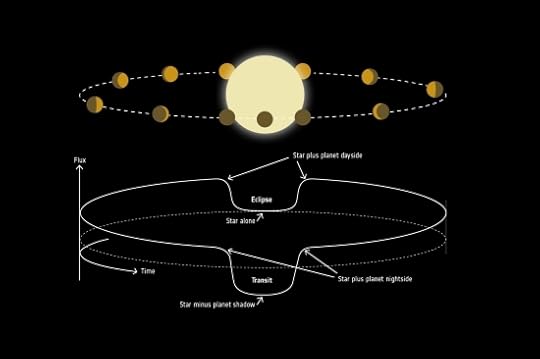
Image: The phase curve method to study extrasolar planets. Depending on a planet’s position with respect to its host star, the total light collected by a telescope will include a varying fraction of light reflected off the planet, in a similar manner to how we experience the phases of the Moon. The planet reflects no light during a phase known as secondary eclipse, when it is hidden from view, whereas it reflects some light shortly before and after this phase. In addition to that, the planet blocks a fraction of the light as it transits in front of the star. Credit: ESA.
Lead would melt in the atmosphere of LTT 9779b, and so, as Crossfield notes, would platinum, chromium and stainless steel in an environment where the day is less than 24 hours long. Co-author Nicolas Cowan (Institute for Research on Exoplanets and McGill University) was involved in the interpretation of the thermal phase curve measurements:
“The planet is much cooler than we expected, which suggests that it is reflecting away much of the incident starlight that hits it, presumably due to dayside clouds. The planet also doesn’t transport much heat to its nightside, but we think we understand that: The starlight that is absorbed is likely absorbed high in the atmosphere, from whence the energy is quickly radiated back to space.”
The data show spectral absorption features indicating carbon monoxide and/or carbon dioxide. This information, along with the global temperature map that emerges from the phase curve data, allows deductions about atmospheric circulation. A second paper on the planet investigates the atmosphere through secondary eclipse observations. The lead author of the second paper is Diana Dragomir (University of New Mexico), with Crossfield as co-author (citations below).
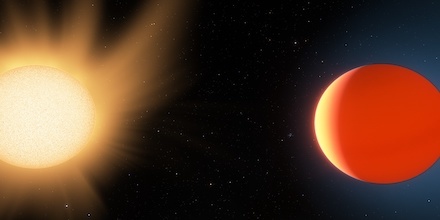
Image: This artist’s impression shows LTT 9779b near the star it orbits, and highlights the planet’s ultra-hot (2000 Kelvin) day-side and its quite-toasty night-side (around 1000 K). Credit: Ethen Schmidt | University of Kansas.
With the primary two-year TESS mission close to completion, we will wind up with 85 percent of the sky surveyed for planets transiting nearby stars. LTT 9779b stands out among the planets thus far surveyed, as the Crossfield et al. paper notes in its conclusion:
LTT 9779b remains one of the best targets of its type – i.e., among highly irradiated hot Neptunes that are highly favorable for thermal emission measurements – and so it is likely to remain one of the most easily-characterizable exoplanets in its class. Future phase curve and eclipse observations of LTT 9779b and other similar planets will provide the impetus for the next generation of global circulation modeling of Neptune-size planets, supporting similar observations of many such objects with JWST, ARIEL, and future observatories.
There is much to probe here, including firming up why comparatively little heat is transported to the night side from the hellish day. The strength of the signal here is a key advantage, making the world an excellent shake-out of the techniques we’ll one day use to probe the atmospheres of smaller worlds in search of biosignatures.
The paper is Crossfield et al., “Phase Curves of Hot Neptune LTT 9779b Suggest a High-metallicity Atmosphere,” Astrophysical Journal Letters Vol. 903, No. 1 (26 October 2020). Abstract available. The Dragomir et al. paper is “Spitzer Reveals Evidence of Molecular Absorption in the Atmosphere of the Hot Neptune LTT 9779b,” Astrophysical Journal Letters Vol. 903, No. 1 (26 October 2020). Abstract.






October 23, 2020
Seeing Earth as a Transiting World
Taking advantage of the fact that most major bodies in our Solar System orbit in roughly the same plane around the Sun, Cornell’s Lisa Kaltenegger, working with Joshua Pepper (Lehigh University), has gone on to ponder the implications of the ecliptic plane, traced out as the plane of Earth’s orbit around the Sun, for exoplanet studies. We’re in the realm of transit detection here, because what the authors want to know is not what we see on the ecliptic so much as what extraterrestrial observers would see if they were on the same plane. Says Kaltenegger:
“Let’s reverse the viewpoint to that of other stars and ask from which vantage point other observers could find Earth as a transiting planet. If observers were out there searching, they would be able to see signs of a biosphere in the atmosphere of our Pale Blue Dot, And we can even see some of the brightest of these stars in our night sky without binoculars or telescopes.”

Kaltenegger is director of Cornell’s Carl Sagan Institute and she takes a Saganesque perspective: What nearby stars exist that would see Earth as a transiting exoplanet? It’s a question with SETI potential because another civilization detecting biosignatures on Earth might conceivably target us for deliberate broadcasts. The paper defines an Earth Transit Zone (ETZ), that region from which the Earth could be seen transiting the Sun. It is a thin strip around the ecliptic as projected onto the sky, with a width of 0.528°.
This is a region of the search space that has seen recent attention as the quality of our catalogs improves. A 2016 paper by René Heller and Ralph Pudritz had identified a slightly narrower ‘restricted’ ETZ defining a region where exo-astronomers would see Earth transit for more than 10 hours, finding 82 stars within 1000 parsecs (3260 light years) in this zone. Heller and Pudritz used Hipparcos data and extrapolated their result to estimate that about 500 stars should exist in that region, while a later paper by Robert Wells found roughly twice that number (citations below).
Mindful of the limitations of the datasets used in these studies, Kaltenegger and Pepper take advantage of the more precise measurements of stellar distance now available through the Gaia mission’s Data Release 2 (DR2), while excluding evolved stars and those with poorly measured distances. The authors note that one particular advantage of the Gaia data is the measurement of parallax distances to fainter, late-type dwarf stars. They operate with a focus on main sequence stars as the best targets to search for biosignatures. Also in play here is the TESS Input Catalog version 8, used by TESS scientists to select target stars, which provides stellar distances, effective temperatures and approximate luminosity.
Out of this Kaltenegger and Pepper identify 1004 main sequence stars within 100 parsecs (326 light years) that would see Earth as a transiting planet. Two of these are known from the K2 mission to be exoplanet hosts. If Earth-size planets in the habitable zone occurred at a rate of 10 percent, this would lead to roughly 100 Earth-class planets in the habitable zone capable of observing a transiting Earth, although the authors are quick to note that estimates of the occurrence rate of such planets range widely and depend upon how habitable zone limits are chosen. We are also early in the game — how complete are our catalogs, and what are we not detecting?
“Only a very small fraction of exoplanets will just happen to be randomly aligned with our line of sight so we can see them transit.” Pepper adds. ”But all of the thousand stars we identified in our paper in the solar neighborhood could see our Earth transit the sun, calling their attention.”
Animation: Cornell astronomer Lisa Kaltenegger and Lehigh University’s Joshua Pepper have identified 1,004 main-sequence stars – similar to our Sun – that might contain Earth-like planets in their own habitable zones within about 300 light-years of here, which should be able to detect Earth’s chemical traces of life. Credit: John Munson/Cornell University.
The closest star in the ETZ is found to be 28 light years from the Sun. The bulk of the sample consists of red dwarf stars. 12 percent are K stars; 6 percent G-class stars like the Sun; 4 percent are F stars and 1 percent A-class stars. Breakthrough Listen is already searching the ETZ, and the paper notes that TESS is to begin searching for transiting planets in the ecliptic next year, so the list generated here provides a helpful set of targets.
This interesting note on stellar motion ends the paper, reminding us how mutable is our view of the heavens:
For the closest stars, their high proper motion can move them into and out of the vantage point of seeing our Earth block the light from our Sun in hundreds of years: For example, Teergarden’s star – which hosts two known non-transiting Earth-mass planets – will enter the ETZ in 2044 and be able to observe a transiting Earth for more than 450 yr (Zechmeister et al. 2019) before leaving the ETZ vantage point.
Thus, the stars which could have seen Earth when life started to evolve are a different set to the ones which can spot signs of life on our planet now compared to those which will see it transit in the far future: Therefore, our list presents a dynamic set of our closest neighbours, which currently occupy a geometric position, where Earth’s transit could call their attention.
The paper is Kaltenegger & Pepper, “Which stars can see Earth as a transiting exoplanet?” Monthly Notices of the Royal Astronomical Society: Letters, Vol. 499, Issue 1 (November, 2020), pp. L111-L115 (full text). The Heller & Pudritz paper is “The Search for Extraterrestrial Intelligence in Earth’s Solar Transit Zone,” Astrobiology Vol. 16, No. 4 (15 April 2016). Abstract. The Wells et al. paper is “Transit visibility zones of the Solar system planets,” Monthly Notices of the Royal Astronomical Society Vol. 473, Issue 1 (January 2018), pp. 345-354 (abstract).






October 22, 2020
Back into the Clouds of Venus
We’re a long way from knowing what is going on in terms of possible life in the clouds of Venus, but one thing is already clear: The phosphine signature, as well as its implications, is going to be thrashed out in the journals, as witness a new study from Rakesh Mogul (Cal Poly Pomona, Pomona, CA) and colleagues that looks at data from the Pioneer-Venus Large Probe Neutral Mass Spectrometer (LNMS), dating back to the Pioneer Venus Multiprobe mission in 1978. These data seem to support the presence of phosphine, while leaving its origin unknown.
But Clara Sousa-Silva (Harvard-Smithsonian Center for Astrophysics), who was involved in the earlier phosphine work led by Jane Greaves at Cardiff University (see What Phosphine Means on Venus), subsequently examined data collected in 2015 at Mauna Kea and found no sign of phosphine. And now we have another paper, this one submitted to Science by Ignas Snellen and team (Leiden University), that carries its message in the title: “Re-analysis of the 267-GHz ALMA observations of Venus: No statistically significant detection of phosphine.”
Finally, let me mention a study led by Arijit Manna (Midnapore City College, West Bengal, India) reporting on a possible detection of the amino acid glycine in the Venusian clouds. I’ve given citations for all of these papers below.
There are all kinds of reasons for data discrepancies on phosphine depending on its possible distribution in Venus’ atmosphere, so until we get further information, we’re left to speculate. But let’s welcome Venus back into the spotlight. I’m glad to see the re-emergence of public interest, and the fortunes of Venus in terms of future mission desirability are obviously on the rise, something the Venus science community must welcome as parched desert-crossers welcome an unexpected flowing spring.
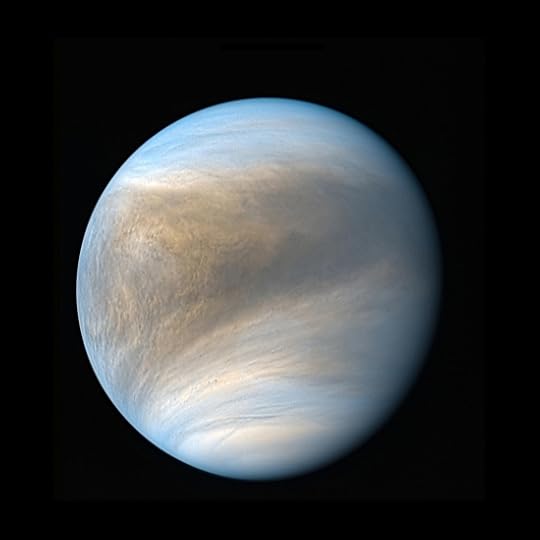
Image: Venus from the perspective of the Japanese Akatsuki probe. Credit: JAXA/ISAS/DARTS/Damia Bouic.
Some kind of biology in the Venusian clouds might even implicate Earth and the possibility of biological spread through rocky debris. While speculation continues, I’m interested in the orbital movements of the Mercury-bound BepiColombo probe, which happened to be approaching Venus in October, using the planet to bleed off velocity as it nudges into the innermost system. It will hardly resolve the matter, but Venus and BepiColombo are intimately connected not only gravitationally but thanks to the opportunity Venus offers to check out key onboard systems.
BepiColombo is actually a combination mission, including the Mercury Planetary Orbiter (MPO), constructed by the European Space Agency, and the Mercury Magnetospheric Orbiter (MMO), a product of the Japan Aerospace Exploration Agency (JAXA). The duo are currently joined but will separate into individual orbits once Mercury is attained.
Two Venus flybys are in the works, as we recently saw in these pages, and the first of these, which took place on October 15, brought the craft within 11,000 kilometers of the planet. BepiColombo is swapping some of its kinetic energy to Venus as it in turn reduces speed, with the second Venus flyby planned for August of 2021 and six close Mercury flybys before the craft enters orbit around the planet at the end of 2025. We now get the chance to test BepiColombo’s MErcury Radiometer and Thermal Infrared Spectrometer (MERTIS), which has already been tested in an earlier Earth/Moon flyby that took place in our COVID spring.
Designed to measure the spectra of rock-forming materials on Mercury’s surface, MERTIS can likewise use its infrared sensors to probe the Venusian atmosphere, with a closer approach pending in the second flyby. According to German aerospace center DLR, MERTIS is sensitive to wavelengths of 7 to 14 and 7 to 40 micrometers respectively in its two uncooled radiation sensors. Both sensors were used during the approach to Venus and approximately 100,000 individual images are expected. At the same time, the Japanese Venus orbiter Akatsuki conducted its own observations, along with Earth-based instruments both professional and amateur.
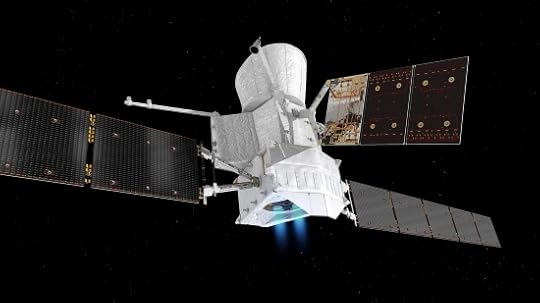
Image: BepiColombo on the long journey to Mercury. Credit: ESA/ATG Medialab.
Phosphine is a short-lived molecule, suggesting that a source on Venus or in its atmosphere is replenishing it, and scientists are still trying to find out if abiotic factors could be in play here, including the possibility of volcanism or reactions following meteorite strikes, even lightning discharges. MERTIS and five other activated instruments on the Mercury Planet Orbiter will not be able to detect phosphine from the flyby distance, but the BepiColombo team has reasons for making these observations that do not involve the gas, says Gisbert Peter, MERTIS project manager at the DLR Institute of Optical Sensor Systems, where the instrument was built:
“During the Earth flyby, we studied the Moon, characterising MERTIS in flight for the first time under real experimental conditions. We achieved good results. Now we are pointing MERTIS towards a planet for the first time. This will allow us to make comparisons with measurements taken prior to the launch of BepiColombo, to optimise operation and data processing, and to gain experience for the design of future experiments.”
Peter Wurz is project leader on STROFIO, which is a mass spectrometer designed at the University of Bern to record the atmosphere of Mercury and examine its composition. Wurz anticipates the results at Venus using not just data from STROFIO but also the spacecraft’s MIPA and PICAM instruments, likewise developed at the university.
“We are expecting data from the ionized particles in Venus’ atmosphere from these two instruments, which are switched on during the Venus flyby. The amount of particle loss and its composition can be determined using the two instruments.”
All of which is an excellent workout for BepiColombo, but MERTIS can also be expected to examine sulphur dioxide concentrations, a reduction of which was recorded about ten years ago. Meanwhile, scientists can study Venus’ atmospheric composition, with the instruments aboard the Japanese Mercury Magnetospheric Orbiter tracking its structure and dynamics. Expect no answers to the astrobiological riddle, but helpful data about Venus otherwise.
And isn’t it interesting seeing how tricky it is to get into the inner system? All those flybys point back to Mariner 10, which used an initial Mercury flyby to enable additional close passes at the planet — these calculations came from Giuseppe ‘Bepi’ Colombo, the Italian physicist for whom the current mission is named. The recent maneuver reduced the craft’s relative speed compared to Mercury to 1.84 kilometers per second, the goal being to orbit the Sun at close to Mercury’s speed and eventually become captured by the gravity of the small world.
The paper referenced in the first paragraph is Mogul et al., “Is Phosphine in the Mass Spectra from Venus’ Clouds?” available as a preprint. The Sousa-Silva paper is “A stringent upper limit of the PH3 abundance at the cloud top of Venus,” in press at Astronomy & Astrophysics (abstract). The paper on glycine is Manna et al., “Detection of simplest amino acid glycine in the atmosphere of the Venus,” submitted to Science (preprint). The “Snellen paper is “Re-analysis of the 267-GHz ALMA observations of Venus: No statistically significant detection of phosphine,” submitted to Science (abstract).






October 21, 2020
OSIRIS-REx: Sample Collection at Asteroid Bennu
A spacecraft about the size of an SUV continues operations at an asteroid the size of a mountain. The spacecraft is OSIRIS-REx, the asteroid Bennu, and yesterday’s successful touchdown and sample collection attempt elicits nothing but admiration for the science team that offered up the SUV comparison. They’re collecting materials with a robotic device 321 million kilometers from home. Yesterday’s operations seem to have gone off without a hitch, the only lingering question being whether the sample is sufficient, or whether further sampling in January will be needed.
Preliminary data show that today's sample collection event went as planned
October 20, 2020
TOI-1266: Confirming Two Planets around a Red Dwarf
The SAINT-EX telescope, operated by NCCR PlanetS, produces a nice resonance as I write this morning. The latter acronym stands for the National Centre of Competence in Research PlanetS, operated jointly by the University of Bern and the University of Geneva. The former, SAINT-EX, identifies a project called Search And characterIsatioN of Transiting EXoplanets, and the team involved explicitly states that they shaped their acronym to invoke Antoine de Saint-Exupéry, legendary aviator and author of, among others, Wind, Sand and Stars (1939), Night Flight (1931) and Flight to Arras (1942).

I’ve talked about Saint-Exupéry now and again throughout the history of Centauri Dreams, not only because he was an inspiration for my own foray into flying, but also because for our interstellar purposes he is credited with this inspirational thought:
“If you want to build a ship, don’t drum up the men to gather wood, divide the work and give orders. Instead, teach them to yearn for the vast and endless sea.”
I say Saint-Exupéry is ‘credited’ with this because it seems to be a condensation of a longer passage that appeared in his 1948 title La Citadelle and I’ve never been able to track the oft-quoted short version down to an original in this specific form. No matter, it’s a grand thought and it plays to our passions as explorers and mappers of new worlds.
So good for NCCR PlanetS for the nod to a favorite writer, and thanks for its recent work at TOI-1266, a red dwarf now known to host at least two planets. The confirmation was achieved with the SAINT-EX robotic 1-meter telescope that the project operates in Mexico; the paper was recently published in Astronomy & Astrophysics. TOI identifies a TESS Object of Interest, meaning the object had been considered promising for follow-up work to validate the candidate signatures as planets. The paper on TOI-1266 provides the needed confirmation.
Here’s what we know: TOI-1266 b is an apparent sub-Neptune about two and a half times the diameter of the Earth that orbits the primary in 11 days. TOI-1266 c is closer in size to a ‘super-Earth’ in being about one and a half times the size of our planet in a 19-day orbit.
The orbits are circular, co-planar and stable. Referring to the more than 3000 transiting planets thus far identified, which includes 499 with more than a single transiting world, the authors discuss distinctive planetary populations. Both planets at TOI-1266 are found at what lead author Brice-Olivier Demory calls the ‘radius valley,’ for reasons explained in the paper:
This large sample of transiting exoplanets allows for in-depth exploration of the distinct exoplanet populations. One such study by Fulton et al. (2017) identified a bi-modal distribution for the sizes of super-Earth and sub-Neptune Kepler exoplanets, with a peak at ∼1.3 R⊕ and another at ∼2.4 R⊕. The interval between the two peaks is called the radius valley and it is typically attributed to the stellar irradiation received by the planets, with more irradiated planets being smaller due to the loss of their gaseous envelopes.

Image: Size of TOI-1266 system compared to the inner solar system at a scale of one astronomical unit, the distance between the Earth and the Sun. The orbital distances of the two exoplanets discovered around the star TOI-1266, which is half of the size of the Sun, are smaller than Mercury’s orbital distance. TOI-1266 b, the closest planet to the star at a distance of 0.07 astronomical units, has a diameter of 2.37 times that of Earth’s and is therefore considered a sub-Neptune. TOI-1266 c, at 0.01 astronomical units from its star and with 1.56 times the Earth’s diameter, is considered a super-Earth. For each planetary system, the star’s diameter and the orbital distances to its planets are shown in scale. The relative diameter of all planets of both systems are on scale, being TOI-1266 b the largest planet and Mercury the smallest. The zoom-in to TOI-1266, in the lower part of the image, shows that the irradiation received by TOI-1266 c from its star is 21% larger than the irradiation received by Venus from the Sun in the upper part of the image. © Institute of Astronomy, UNAM/ Juan Carlos Yustis.
It’s useful to have a super-Earth and a sub-Neptune in the same system because this allows for tighter constraints on formation models. The paper argues that this will be “a key system to better understand the nature of the radius valley around early to mid-M dwarfs.”
It’s also interesting that TOI-1266’s small size and relative proximity (about 117 light years) make it a possible target for atmospheric studies with future instruments. The authors show that the James Webb Space Telescope should be able to operate well above the observatory’s noise floor level in performing transmission spectroscopy here (i.e., viewing changes in the star’s light as the either planet moves first in front of and then is eclipsed by the star). The TOI-1266 planets compare favorably to TRAPPIST-1b on this score, and the host star shows no evidence of significant starspots that might distort the signal of the exoplanet atmospheres.
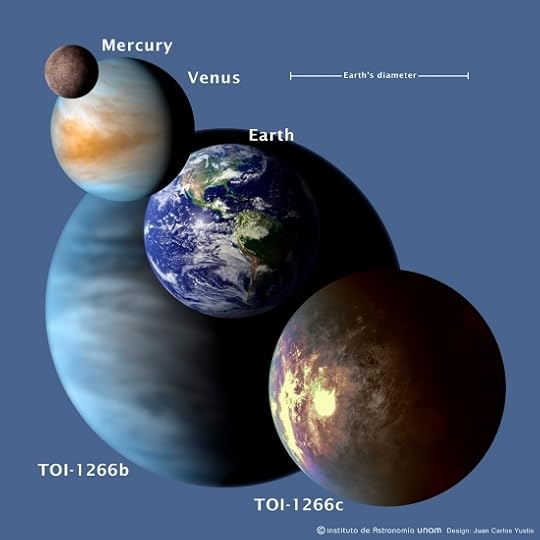
Image: Direct comparison among the planets of TOI-1266 system with the interior planets of the solar system. © Institute of Astronomy, UNAM / Juan Carlos Yustis.
The paper is Brice-Olivier Demory et al., “A super-Earth and a sub-Neptune orbiting the bright, quiet M3 dwarf TOI-1266,” Astronomy & Astrophysics Volume 642 (2 October 2020). Abstract.






Paul Gilster's Blog
- Paul Gilster's profile
- 7 followers




